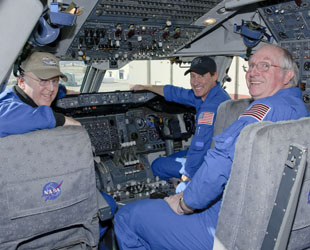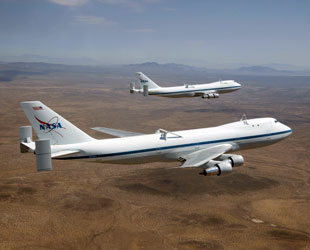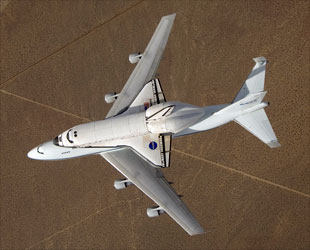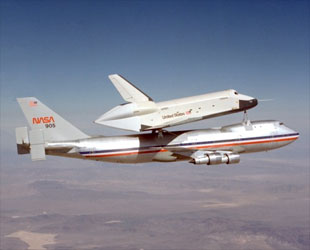February 10, 2012 – One of only two planes that carried NASA's space shuttles piggy-back on cross-country rides was retired this week after more than 20 years of service.
NASA 911, one of the two Boeing 747 jetliners that were modified for use as a Shuttle Carrier Aircraft (SCA) made its last flight Wednesday (Feb. 8). The four-engine jumbo jet, which was used to ferry shuttles between their west coast landing site and east coast launch site, flew its final mission making the short hop from NASA's Dryden Flight Research Center at Edwards Air Force Base to Dryden's Aircraft Operations Facility located adjacent to Air Force Plant 42 in Palmdale, California. The flight lasted about 20 minutes.
With the end of the shuttle program last summer, only one of the carrier aircraft — the original, NASA 905 — is still needed to fly the orbiters to their respective museums for public display.

Jeff Moultrie (left), Bob Zimmerman, and Henry Taylor of Johnson Space Center's Aircraft Operations Directorate as photographed in the cockpit of NASA Shuttle Carrier Aircraft 911 after crewing its final flight (NASA/Tony Landis) |
In its retirement, NASA 911 will be used as a source of spare parts to keep NASA's Stratospheric Observatory for Infrared Astronomy (SOFIA) flying. Also based around a Boeing 747, SOFIA uses the jetliner as a platform for a 100-inch (2.5-meter) reflecting telescope.
Second in, first out
NASA 911, a Boeing 747-100SR short range version, was the second of NASA's two shuttle carrier aircraft. Built in November 1973, it originally flew as a commercial airliner operated by Japan Air Lines for about 15 years.

NASA's two Shuttle Carrier Aircraft 905 (foreground) and 911 as they flew in formation over the Southern California high desert in the Edwards Air Force Base Test Range. (NASA/Carla Thomas) |
Acquired by NASA in 1989, NASA 911 — or as registered with the Federal Aviation Administration, N911NA — was then modified for shuttle service by the Boeing Company.
Among the changes made to it were the addition of three struts protruding from the top of its fuselage on which the orbiters were mounted and the installation of two vertical stabilizers to steady it in flight.
All of the jet's interior furnishings and equipment that was located to the rear of its forward doors were removed and additional instrumentation was added to allow the flight crew to monitor the electrical loads while the aircraft was ferrying a shuttle.
NASA 911 was delivered to the space agency on Nov. 20, 1990. Over the course of two decades, it carried shuttles between California and Florida, either returning them to their launch site after landing on the west coast or ferrying them to Palmdale for modifications and upgrades.

Overhead view of space shuttle Atlantis atop NASA 911 as it flew over California's high desert on a ferry flight back to the Kennedy Space Center in Florida. (NASA/Jim Ross) |
As just one example, NASA 911 returned space shuttle Atlantis from Edwards Air Force Base to Kennedy Space Center in Florida after the orbiter flew the final mission to service the Hubble Space Telescope.
Including its 20-minute final flight, NASA 911 amassed a total of 33,004.1 hours in flight over its more than 38-year flying career.
Museum-bound
As NASA 911 begins its new role as a parts provider for SOFIA, its predecessor still has a few shuttle ferry flights to complete.
NASA 905, or N905NA, will take to the air on April 17 to deliver shuttle Discovery to the Smithsonian's Steven F. Udvar-Hazy Center near Washington, DC. The jet will then be reunited with the very first orbiter it flew, the prototype Enterprise, for a ferry flight to New York City.
Enterprise, which has been on display at the Udvar-Hazy Center since 2003, will go on exhibit at the Intrepid Sea, Air and Space Museum in Manhattan later this summer.

The shuttle prototype Enterprise rides atop NASA's first Shuttle Carrier Aircraft (SCA), NASA 905, during the first of the shuttle program's Approach and Landing Tests (ALT) at the Dryden Flight Research Center, California, in 1977. (NASA) |
Finally in October, shuttle Endeavour will ride piggy-back atop NASA 905 to Los Angeles, where the orbiter will go on display at the California Science Center.
To prepare for those final ferries, Dryden Flight Research Center has been shipping out ground and airborne support equipment that supported shuttle landing and servicing operations over the past 35 years — including parts from NASA 911.
The overland strongback transporter that carried shuttles Enterprise, Columbia, Challenger, Discovery and Atlantis from their final assembly location in Palmdale to Dryden in the late 1970s through early 1980s was disassembled and shipped to Los Angeles late last month.
It will be used to transport Endeavour from Los Angeles International Airport to the California Science Center and then will be part of the orbiter's temporary display until its permanent exhibit is completed.
NASA technicians also removed the pedestals from the aft shuttle mounting struts atop NASA 911. The pedestals will be used to secure Enterprise to a barge that will float the orbiter from JFK International Airport to the Intrepid by way of New York's Hudson River.
